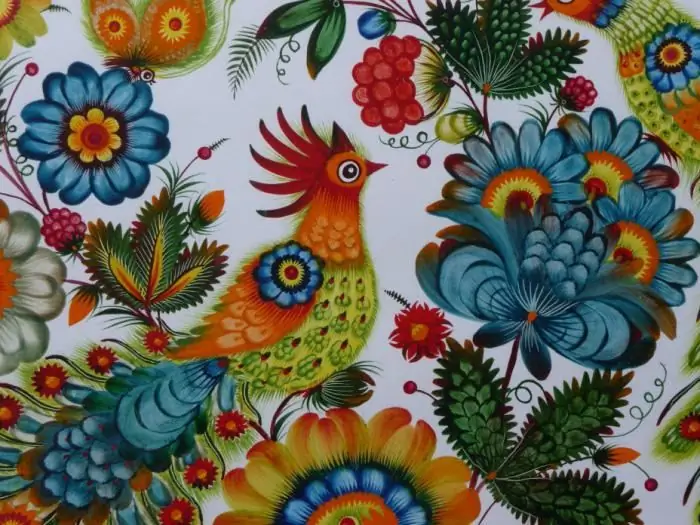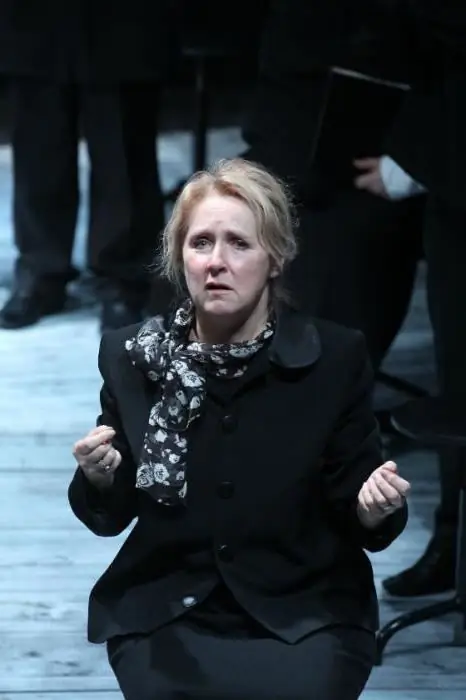2026 Author: Leah Sherlock | [email protected]. Last modified: 2025-01-24 17:46:27
Decorative (from Latin "decoro" - "decorate") painting is part of an architectural ensemble or a work of arts and crafts. Its main purpose is to decorate and emphasize the structure of a building or the function of an object, so decorative painting is closely related to works of applied art or architectural structures.

In the latter case, such painting is called monumental, not only because of its size, but also because of its connection with architecture, which most often bears the features of monumentalism. Both physically and in content, this painting is inseparable from the object for which it was performed, and this is its difference from easel painting. It is this functional connection that determines the plot, technique, form, and methods of performing a work of art.
Decorative painting in its development has several millennia. The oldest specimens were found on the walls of caves, and although it is not yet possible to determine the exact time of their application, scientists believe that they belong to the Paleolithic. These comparatively realistic images, scratched with sharp tools or inscribed in blacksoot and red clay, can no doubt be called painting. The genre painting of Ancient Egypt has a more developed look - murals of funerary structures depicting scenes of fishing, hunting, working life, and military operations. Despite many conventions in the depiction of figures, the drawings of the Egyptians are not devoid of realism and quite accurately convey the movements and characteristic poses of people, animals, and birds.

Decorative antique painting of Greece and Ancient Rome was widely used to decorate public and residential buildings, but at the same time it served religious and political purposes. Decorative compositions and picturesque ornaments placed on walls and vaults were greatly developed. Over time, the colored stones of the mosaic began to be supplemented with pieces of glass of various colors.
In Western Europe, the early period of the Middle Ages is characterized by the fact that decorative painting on the walls is replaced by painted glass - stained glass. This is due to the lack of light: until the 12th century, window openings in temples were small, and wall paintings were poorly lit. The stained glass windows, on the other hand, glowed with bright colors. In civil buildings, paintings were replaced by carpets that completely covered the cold stone walls. At first they were brought from the East, and then they began to make them in Europe. Mostly the plots reproduced religious themes, but gradually illustrations of chivalrous deeds, symbolic images of crafts and arts, virtues and vices began to appear, gradually they acquired artistic realism.

In Russia, fresco decorative painting was developed even earlier than in Western Europe. Having adopted its practice from Byzantium, the Russians immediately introduced their vision of the world into it. The abstract, conditional nature of Byzantine mosaics and frescoes was alien to Russian masters, they brought clarity and simplicity of expression of ideas to them. It is no coincidence that painting is a Russian word that indicates the realism of this art, its connection with living images. Monumental and decorative painting from ancient times to this day has been involved in the design of architectural space and the organization of an ideologically rich environment for a person.
Recommended:
Chinese literature: a brief excursion into the history, genres and features of the works of contemporary Chinese writers

Chinese literature is one of the oldest art forms, its history goes back thousands of years. It originated in the distant era of the Shang Dynasty, simultaneously with the appearance of the so-called buts - "fortune-telling words", and throughout its development has been constantly changing. The trend in the development of Chinese literature is continuous - even if the books were destroyed, then this was certainly followed by the restoration of the originals, which were considered sacred in China
Zhostovo painting. Elements of Zhostovo painting. Zhostovo factory of decorative painting

Zhostovo painting on metal is a unique phenomenon not only in Russia, but all over the world. Volumetric, as if freshly plucked flowers, are filled with color and light. Smooth color transitions, the play of shadows and highlights create a bewitching depth and volume in each work of Zhostovo artists
Petrikovskaya decorative painting. Petrikovskaya painting for beginners

Fine art in our time does not lose its popularity, and despite the fact that technological progress replaces many traditional forms of human activity. Moreover, many forms of creativity are now being revived, in which interest was not so obvious just a few years ago. Petrikovskaya painting is a field of activity that attracts many people. What is the secret of such popularity?
Artist Natalia Akimova. Born into the light, gone into cruel sadness

Clearly, dryly, in the lines of the biographies of famous people, politicians, artists, a certain trend can be traced. The more famous the person, her life, full of tragic or, conversely, joyful events, accomplishments, achievements - the less information in these figures that the reader is most interested in learning. A striking example of this fact is a brief summary of the life and career of an actress named Natalya Akimova. It can be said that the quiet, calm life of an ordinary woman from the outback
What is a museum? Brief excursion

Museum! How much meaning in this word! And the number of rarities contained there is amazing, as well as their cost. Some exhibits have no price at all, because they have been preserved in a single copy for all mankind! What is a museum? From a scientific point of view, this is a socio-cultural institution where they collect, study, store all kinds of monuments of art, science and technology, as well as history and other spheres of human activity

